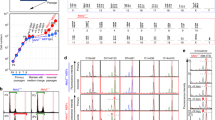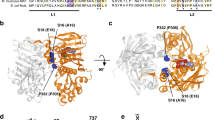Abstract
Many reports have shown a link between mismatch repair (MMR) deficiency and loss of normal cell cycle control, particularly loss of G2 arrest. However almost all of these studies utilized transformed cell lines, and thus the involvement of other genes in this phenotype cannot be excluded. We have examined the effects of cisplatin treatment on primary embryo fibroblasts (MEFs) derived from mice in which the MMR gene Msh2 had been inactivated (Msh2−/−). This analysis determined that both primary Msh2−/− and wild type (WT) fibroblasts exhibited an essentially identical G2 arrest following cisplatin treatment. Similarly, we observed a cisplatin-induced G2 arrest in immortalized MMR deficient (Mlh1−/− and Pms2−/−) and WT MEFs. p53 deficient primary MEFs (p53−/−) exhibited both a clear G2 arrest and an increase in cells with a DNA content of 8N in response to cisplatin. When the Msh2 and p53 defects were combined (p53−/−/Msh2−/−) the G2 arrest was essentially identical to the p53−/− fibroblasts. However, the p53−/−/Msh2−/− fibroblasts demonstrated a further increase in cells with an 8N DNA content, above that seen in the p53−/− fibroblasts. These results suggest that loss of MMR on its own is not enough to overcome G2 arrest following exposure to cisplatin but does play a role in preventing polyploidization, or aberrant DNA reduplication, in the absence of functional p53.
This is a preview of subscription content, access via your institution
Access options
Subscribe to this journal
Receive 50 print issues and online access
$259.00 per year
only $5.18 per issue
Buy this article
- Purchase on Springer Link
- Instant access to full article PDF
Prices may be subject to local taxes which are calculated during checkout



Similar content being viewed by others
References
Anthoney DA, McIlwrath AJ, Gallagher WM, Edlin ARM, Brown R . 1996 Cancer Res. 56: 1374–1381
Arzimanoglou II, Gilbert F, Barber HRK . 1998 Cancer 82: 1808–1820
Bates S, Vousden KH . 1996 Curr. Op. Genet. Dev. 6: 12–19
Brown R, Clugston C, Burns P, Edlin A, Vasey P, Vojtesek B, Kaye SB . 1993 Int. J. Cancer 55: 678–684
Brown R, Hirst GL, Gallagher WM, McIlwrath AJ, Margison GP, van der Zee AG, Anthoney DA . 1997 Oncogene 15: 45–52
Buermeyer AB, Deschenes SM, Baker SM, Liskay RM . 1999 Ann. Rev. Genet. 33: 533–564
Cranston A, Bocker T, Reitmair AH, Palazzo J, Wilson T, Mak TW, Fishel R . 1997 Nature Genet. 17: 114–118
Cross SM, Sanchez CA, Morgan CA, Schimke MK, Ramel S, Idzerda RL, Raskind WH, Reid BJ . 1995 Science 267: 1353–1356
Dasika GK, Lin SCJ, Zhao S, Sung P, Tomkinson A, Lee EYHP . 1999 Oncogene 18: 7883–7899
Davis TW, Wilson-Van Patten C, Meyers M, Kunugi KA, Cuthill S, Reznikoff C, Garces C, Boland CR, Kinsella TJ, Fishel R, Boothman DA . 1998 Cancer Res. 58: 767–778
Donehower LA, Godley LA, Aldaz CM, Pyle R, Shi YP, Pinkel D, Gray J, Bradley A, Medina D, Varmus HE . 1995 Genes Dev. 9: 882–895
Duckett DR, Bronstein SM, Taya Y, Modrich P . 1999 Proc. Natl. Acad. Sci. USA 96: 12384–12388
Dudenhoffer C, Rohaly G, Will K, Deppert W, Wiesmuller L . 1998 Molec. Cell. Biol. 18: 5332–5342
Durant S, Morris M, Illand M, Mackay HJ, McCormick C, Hirst GL, Borts RH, Brown R . 1999 Current Biol. 9: 51–54
El-Deiry WS, Tokino T, Velculescu VE, Levy DB, Parsons R, Trent JM, Lin D, Mercer WE, Kinzler KW, Vogelstein B . 1993 Cell 75: 817–825
Fink D, Aebi S, Howell SB . 1998 Clin. Cancer Res. 4: 1–6
Gong J, Costanzo A, Yang H, Melino G, Kaelin WG, Levrero M, Wang JYJ . 1999 Nature 399: 806–809
Hawn MT, Umar A, Carethers JM, Marra G, Kunkel TA, Boland CR, Koi M . 1995 Cancer Res. 55: 3721–3725
Hickman MJ, Samson LD . 1999 Proc. Natl. Acad. Sci. USA 96: 10764–10769
Keurbitz SJ, Plunkett BS, Walsh WV, Kastan MB . 1992 Proc. Natl. Acad. Sci. USA 89: 7491–7495
Koi M, Umar A, Chauhan DP, Cherian SP, Carethers JM, Kunkel TA, Boland CR . 1994 Cancer Res. 54: 4308–4312
Lee S, Elenbaas B, Levine A, Griffith J . 1995 Cell 81: 1013–1020
Nehme A, Baskaran R, Aebi S, Fink D, Nebel S, Cenni B, Wang JYJ, Howell SB, Christen RD . 1997 Cancer Res. 57: 3253–3257
Notterman D, Young S, Wainger B, Levine AJ . 1998 Oncogene 17: 2743–2751
Prolla TA, Baker SM, Harris AC, Tsao J, Yao X, Bronner CE, Zheng B, Gordon M, Reneker J, Arnheim N, Shibata D, Bradley A, Liskay RM . 1998 Nature Genet. 18: 276–279
Sugawara N, Paques F, Colaiacovo M, Haber JE . 1997 Proc. Natl. Acad. Sci. USA 94: 9214–9219
Toft NJ, Winton DJ, Kelly J, Howard LA, Dekker M, te Riele H, Arends MJ, Wyllie AH, Margison GP, Clarke AR . 1999 Proc. Natl. Acad. Sci. USA 96: 3911–3914
Tomlinson I, Bodmer W . 1999 Nature Med. 5: 11–12
Acknowledgements
We would like to thank Dr RM Liskay for the immortalized MEF cell lines. We would also like to thank Dr HT Riele for the Msh2 deficient mice. This work was supported by the Cancer Research Campaign (UK). AR Clarke is supported by the Royal Society.
Author information
Authors and Affiliations
Rights and permissions
About this article
Cite this article
Strathdee, G., Sansom, O., Sim, A. et al. A role for mismatch repair in control of DNA ploidy following DNA damage. Oncogene 20, 1923–1927 (2001). https://doi.org/10.1038/sj.onc.1204276
Received:
Revised:
Accepted:
Issue Date:
DOI: https://doi.org/10.1038/sj.onc.1204276
Keywords
This article is cited by
-
MLH1 expression sensitises ovarian cancer cells to cell death mediated by XIAP inhibition
British Journal of Cancer (2009)
-
53BP1 deficiency in intestinal enterocytes does not alter the immediate response to ionizing radiation, but leads to increased nuclear area consistent with polyploidy
Oncogene (2007)
-
Genetic dissection of the role of p21Cip1/Waf1 in p53-mediated tumour suppression
Oncogene (2007)
-
Total Parenteral Nutrition Leads to Alteration of Hepatocyte Cell Cycle Gene Expression and Proliferation in the Mouse
Digestive Diseases and Sciences (2007)
-
Different cell cycle modulation following treatment of human ovarian carcinoma cells with a new platinum(IV) complex vs cisplatin
Investigational New Drugs (2007)



